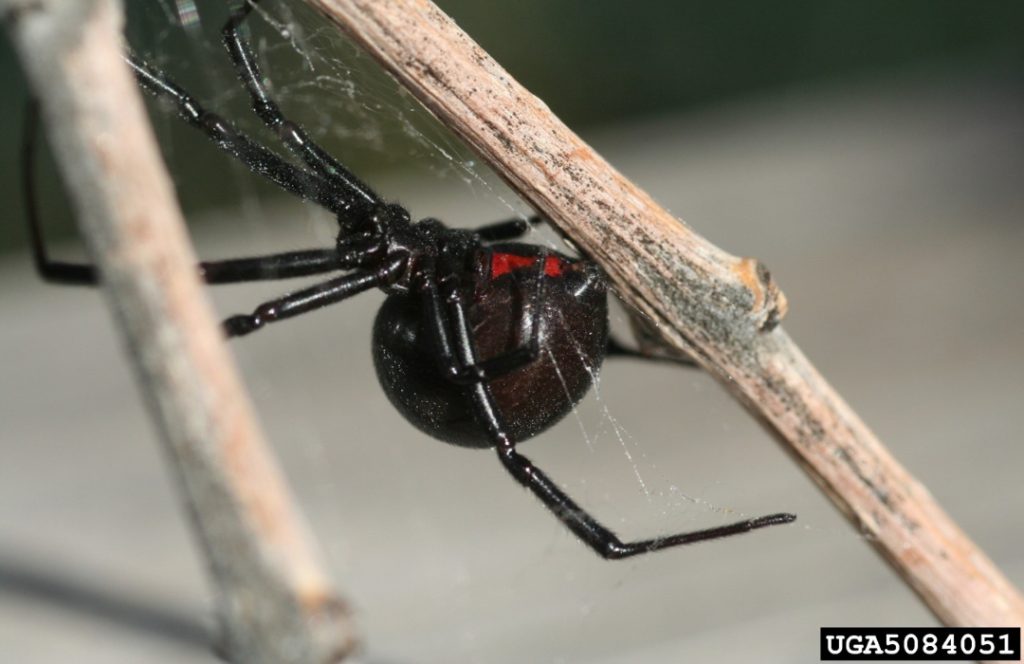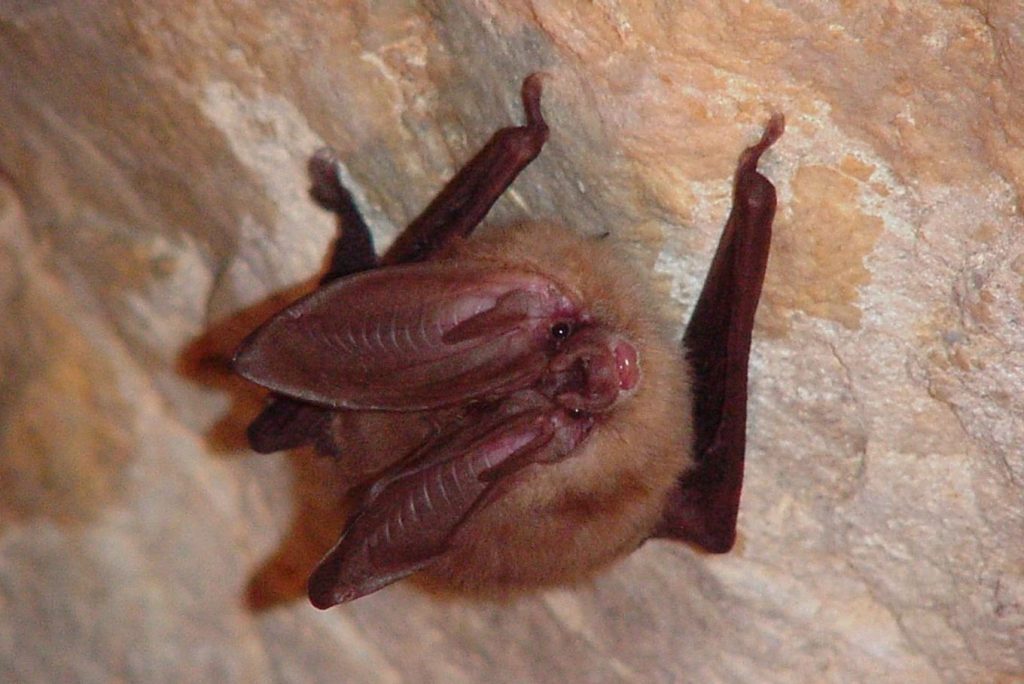Halloween’s most infamous animals: Why spiders and bats don’t deserve their creepy, spooky reputation

Bugwood.org/Courtesy Photo
Halloween is an opportunity to celebrate that which is creepy, spooky, scary and sometimes stranger than fiction. And for many, the celebrations conjure up images of two specific animals: spiders and bats.
However, for the experts who have dedicated themselves to studying and educating others about these species, this fear is unwarranted.
Fighting arachnophobia with knowledge
“Humans have such a fear and fascination with spiders,” said Maia Holmes, director of Colorado State University’s bug zoo and the education and outreach coordinator for the university’s agricultural biology department.
“People love being scared and enjoying safe amounts of scary,” making Halloween the perfect time of year to lean in and get interested in spiders, Holmes added.
Spiders, a member of the greater arachnid family, all have eight legs and two body segments. All spiders have silk-producing spinnerets and fangs, but there are a few ways scientists separate different species. The primary split is between “true spiders” or Labidognatha spiders, which have scissored teeth that move side to side, and mygalomorph spiders, whose mandibles move up and down.
“Ninety-five percent of spiders are true spiders, and then there’s a collection of ancestral spiders or mygalomorphs, like tarantulas, wolf spiders, trapdoor spiders and mouse spiders,” Holmes said.
There are many other differences that scientists see between spider species, including the way they hunt — spinning a web, chasing prey or ambushing it — and the way they spin their webs.
“All spiders can make webs, but they’re going to make different kinds of webs,” Holmes said, listing orb webs, cobwebs and funnel webs as the three main styles.
Spider silk itself is an interesting substance in that it can be both strong and elastic and is antimicrobial and antifungal, Holmes added.
“There are eight different kinds of spider silk, and one spider can make up to six different kinds,” she added. This can include silk that’s thicker, stickier, finer or sheet-like.
One of Holmes’ go-to facts about spiders is that there are certain species of orb weavers whose silk and spider webs are the same width as human brain neurons.
“There’s been some pretty promising research with using that spider webbing as scaffolding to help regrow neurons in areas of the brain that have been damaged and need neuron growth,” Holmes said.
As someone who instead describes spiders as cute, cool, fascinating and charming, Holmes believes that a lot of spider fear comes down to people overestimating their threat level to humans.
“People think spiders are a lot bigger than they are and a lot smarter than they are,” Holmes said. “Not to say that spiders aren’t incredible, but the spider has three concerns in life: staying alive, getting food and having babies. They’re certainly not out there to hunt you down, bite you or come after you. They’re just trying to find a quiet corner to eat bugs.”
In the world, there are only five species of spiders — out of 50,000 known species — that are “medically significant,” Holmes said. A spider is considered medically significant when their venom can cause serious harm to humans.
Of these five, Holmes argued that only two carry a significant threat — and neither live in the United States.
In Colorado, where there are several thousand kinds of spiders, only one — the black widow — is medically significant, Holmes said. (Claims that Colorado has brown recluse spiders, another of the medically significant species, are false, she added.)
“The nice thing about the black widow is its infamy is undeserved,” Holmes said.
While a bite from a black widow can cause unpleasant symptoms — nausea, hyperventilation, pain and, sometimes, “an impending sense of doom” — there have only been three documented deaths in the past 100 years, Holmes said.
“They’re shy, they’re like big, ol’ scaredy cats, so you have to work pretty hard to get them to bite,” Holmes said. “The way people usually end up getting bitten is (black widows) like to hide in dark areas… so if you’re reaching in and it’s there and you put pressure on them like they’re getting squished, that’s where we see a bite, usually.”
As with any spider, Holmes added that the black widow can also choose whether or not to use their venom, and a lot of times, they’re choosing not to.
Rather than focusing on this fear, Holmes believes spiders should be appreciated for their “silent support.”
“They are something that is in the background and something that is ubiquitous, and they are so important to the environment,” Holmes said. “If all spiders magically disappeared overnight, we’d probably start seeing effects of it within a few days.”
This is because spiders not only eat a lot of insects, but there are also entire species that depend on spiders as their food source. Additionally, many spiders are known to contribute to nutrient cycling, which can return nutrients to soils and enhance plant growth and more.
As for Holmes’ top advice in overcoming your fear? Lean in and “watch a spider sometime.”
Debunking the mystery of bats
Dan Neubaum, species conservation program manager at Colorado Parks and Wildlife, describes bats as small and elusive, something that can incite fear in others. However, as a biologist who has spent his career learning about the winged mammals, it only intrigues him further.
“As you learn about the animals, you start to figure out how cool they are, and you start to realize that the things that we’re afraid of about them aren’t really anything to be afraid of,” Neubaum said. “They draw you in and keep you wanting to come back to try to answer more questions. There are so many things we still don’t know about them, and that just makes them a really interesting species or cohort to work with.”
Among some of the lingering questions about bats are when bats mate, how they socialize and how long certain bat species live.
In terms of lifespan, Parks and Wildlife is conducting some research on the topic in Carbondale, tagging Townsend’s big-eared bats. Some of the bats have been alive for nearly 15 years, which is longer than previously expected for such a small mammal, Neubaum said.
“Their whole social environment, how they interact with each other, is super hard to study, and we’re kind of vague on what goes on,” Neubaum said.

Biologists have observed that many species will see males and females split for the summer, with the females forming maternity colonies where they give birth to pups.
“Most of our bat species in Colorado, we do see the females form those maternity colonies, and within those colonies, there has been some documentation of joint care of the young where some individuals will stay with the pups while others leave and go forage, and then they’ll trade off,” Neubaum said.
Researchers have also seen bats return to the same sites year after year, particularly among females.
“You’ve got mothers, grandmothers, aunts and daughters all using these same sites over and over,” Neubaum said. “We’ll even see some of the males come back for the first year or two for short little visits and then those visits tend to drop off as they get older.”
For many years, the list of unknowns also included a question about where bats spent their winters.
“I’ve spent much of my career trying to track bats back to their roost sites to learn about why they’re choosing their sites,” Neubaum said.
What they discovered is that in the fall, many Colorado bats are going back to rock crevices and talus slopes to hibernate for the winter. Part of the reason these sites are selected is that these sites hold cold and consistent temperatures through winter.
“True hibernators let their body temperatures drop down to a couple of degrees above freezing,” Neubaum said. “(Bats) always find those magical little spots that are just above freezing so that they can be that true hibernator and utilize that harsh location that most other animals can’t.”
Their ability to adapt to different environments is one of Neubaum’s favorite things about bats.
“They come up with all these cool adaptations to use parts of the world that would normally not be used by other animals,” he said.
This includes adapting to winter environments when bugs are gone, and flying — something mammals normally cannot do — to take advantage of bugs in the air and using echolocation to hunt in the dark, Neubaum listed.
Echolocation, Neubaum noted, is what’s behind the saying: “blind as a bat,” which is a misnomer because “bats can see quite well.”
“They can see in the dark by using their ears to echolocate, so they can see in the daytime or they can see at night because of their different sensory mechanisms,” he said.
Colorado is home to around 20 species of bats, including both hibernators and migratory species.
“Colorado is kind of a cool place in the bat world because it’s where the plains meet the mountains and the mountains meet the desert, all in one place, and so as a result, we have a pretty decent diversity of bats,” Neubaum said.
Fear around bats could come from a few different concerns and misconceptions.
One is around disease concerns. Bats can carry and transmit rabies, but it’s less than half of 1% that actually get sick with it, Neubaum said.
“Many bats are actually exposed to the virus and don’t get sick and die from it; they actually build up antibodies to it as if we were getting vaccinated,” he added. “They’re the only mammal that we’re aware of that has the ability to do that.”
Another has to do with the erratic way they fly. These “weird little jerky movements” are happening for a few reasons, according to Neubaum.
“Part of what’s going on there is while they’re flying, they’re echolocating or they’re releasing those really high frequency pulses, so when that signal bounces off a bug and comes back to the bat, they’re making these erratic movements to adjust their flight path based on that information,” he said.
Additionally, when bats go in for the kill on a bug, they’re often using their hands (attached to their wing) to grab the bug and bring it to their mouth or their webbed feet and tails to scoop the bug — both of which can lead to little somersaults or rapid flight movements.
Regardless of where a fear of bats originates, “I like to point out to people that they’re like 40 times bigger than a bat, so the bat is really more afraid of you than you are of it,” Neubaum said.

Support Local Journalism

Support Local Journalism
Readers around Steamboat and Routt County make the Steamboat Pilot & Today’s work possible. Your financial contribution supports our efforts to deliver quality, locally relevant journalism.
Now more than ever, your support is critical to help us keep our community informed about the evolving coronavirus pandemic and the impact it is having locally. Every contribution, however large or small, will make a difference.
Each donation will be used exclusively for the development and creation of increased news coverage.









